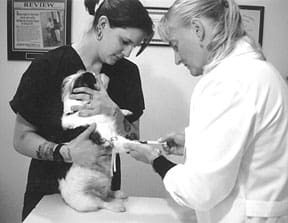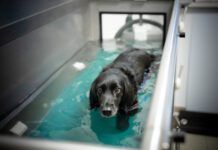For a dog, the perfect life would have love, toys, sunshine, plenty of exercise, just the right amount of good food – and the one crucial thing which makes all of that possible: an immune system that works as nature designed it to work. For all “higher” organisms – from ticks to Texans – the immune system brings good health or takes it away. A healthy, properly functioning immune system operates like the world’s most omnipotent drug. When they’re at the top of their game, this system of body defenders can recognize and annihilate any invading viruses, bacteria, fungi, and parasites. But it’s an incredibly complex system, based in the bone marrow, and interacting intricately with both the blood circulatory and the lymphatic systems. Each part of the system plays a pivotal role in growing, developing, or activating the cells whose actions defend the body from invasion. This complexity, unfortunately, makes it prone to occasional lapses, and sometimes catastrophic failure. Even the healthiest dog is likely to suffer an immune malfunction at some point in his or her life – even if it manifests itself only as an allergy, a recurrent bacterial infection, or an entrenched bronchial virus. But some dogs, like some people, are born with fatal flaws in their immune systems, leaving them vulnerable to disease, and perhaps doomed to an premature death.

For much of the current century, medical science has focused on “fighting disease,” looking for drugs and other medical methods that could be used to destroy the bacteria, viruses, and tumors that threaten lives. But in the last 20 years or so, scientists have come to realize that treatments that help optimize the immune response might be just as effective, if not more effective, at preserving health. Of course, this confirms everything that holistic veterinary practitioners have been saying for decades: “If the dog is truly healthy, he can withstand any disease challenge.” Purpose of the system The immune system is often described in military terms, because it acts in such a similar fashion. The purpose of the immune system is to detect threats to the body and eliminate them, just as armies are supposed to identify threats to a government and put down those threats quickly. Infections – infiltrations, if you will – of any foreign agents elicit a rapidly escalating defensive response. When the system works as it should, the appearance of “invaders” alerts cellular “scouts;” either destroying them immediately, or marking them for destruction by other types of cells. If the initial skirmish is indecisive, the “cold-war” immune system quickly retools, and cellular reinforcements arrive in millions, precisely formulated to attack that particular invader, and programmed to recognize it should it ever return. At least, that’s how it works when the immune “army” is well-staffed, well-supplied, and well-organized. The immune system may actually respond in one of four ways to alien intrusions: • Appropriately: identifying and eliminating the problem before it threatens or inhibits life, as described above • Inappropriately: as when the immune system treats its own cells as invaders, causing what are called auto-immune disorders • Inadequately: as in cancers or immune deficiency disorders • Hyperactively: as with allergies Because there are a number of ways that the immune system can fail, there are a number of approaches that can be taken to rectify or balance the failure. Before you can help correct your dog’s off-kilter immune system, however, you have to know how it’s supposed to work. For example, you wouldn’t want to give a dog treatments that boost immune response if he’s displaying symptoms that indicate his immune system is hyperactive or attacking his own healthy tissues. In this article, we’ll describe the way the immune system is supposed to work. In the next issue, we’ll describe a number of common immune system failures – resulting from inappropriate, inadequate, and hyperactive immune activity – and explain how and where the system is breaking down in each scenario. The final part of this series will describe the most effective approaches, holistic and otherwise, to getting the immune system to act appropriately and effectively. Outside looking in In the course of a lifetime, a typical dog will confront a never-ending onslaught of disease-causing agents. As we all know, dogs seem to enjoy exposing themselves to foul things, deriving intense pleasure from activities which elicit our own most intense displeasure: rolling on carcasses, lapping up sewage, or snacking on last month’s garbage. Any pleasant walk out in the world, in short, can cause him to come home with unwanted (if invisible) visitors, including bacteria, parasites, viruses, fungi, and numerous allergens. Some invaders are more virulent or more cleverly insidious than others, but the power of an antagonist’s ability to make your dog sick depends on a number of factors. One critical factor is the amount of a given disease agent a dog is exposed to. In general, dogs who receive a higher dose of disease agent will display higher infection rates and more severe illness. The entry point of exposure is another important factor. Some viruses, for instance, won’t harm a dog at all if they are introduced to a wound (or even injected into the dog), but will cause extreme illness if breathed into the mucous membranes and lungs. Other disease agent factors include the number of other animals in a given environment (crowding), and local stress levels (including ambient temperature and humidity). Factors unique to your dog – “host factors” – also influence the odds that he will or won’t succumb to an invader’s influence. Most significant is the dog’s inherited predisposition to certain diseases. The quality of the dog’s diet, and nutritional deficiencies or imbalances can affect his ability to defend himself from disease agents. His general health and the concurrent presence of undiagnosed (and thus, untreated) illness will also affect his resistance to disease. Recognizing danger One significant task of the immune system is to identify cells, separating them into two categories: those normally present in the body, or those not normally present in the body – that is, cells that are “self” or “non-self.” Any “non-self” agent that elicits an immune response is referred to generally as an immunogen. The more foreign a cell is (that is, the more it is unlike “self”), the more likely the immune system will respond. Immunity begins in the bone marrow, where stem cells are produced. Stem cells are embryonic cells to which a series of genetic codes are attached. These stem cells are produced in enormous numbers each day, and, according to a coded genetic mechanism that scientists have yet to explain, differentiate into two distinct types of white blood cell (as well as others not directly of interest here) which populate the immune system. Stem cells mature in the thymus and spleen, and rely upon both the lymphatic system and the blood circulatory system to be transported where they need to go in the body. The first type of white blood cells, called myeloid cells, develop into the free-ranging “scout” cells which initiate a dog’s non-specific immune response. These interceptor cells, also called phagocytes, come in three known types: neutrophils (by far the most common) reside in the bone marrow and flow into the bloodstream when needed to fend off run-of-the-mill infections; eosinophils, which, generally, respond to parasitic infestations; and basophils, which trigger the release of histamines involved in allergic reactions. Related to phagocytes are the macrophages, literally, “great eater,” which often arrive first at the site of infection. First lines of defense We like to think of our dogs as entertaining, enjoyable companions. But to viruses, bacteria, and other invaders, our dogs are simply potential cites for incubation and reproduction. These foreign agents use every imaginable method of entry to infect our dogs: some are breathed into the body, while others are swallowed in food or water or absorbed through the skin. Fortunately, healthy dogs have formidable first lines of defense ready and waiting to destroy any intruders. Not many people are aware that the dog’s skin is a disease-preventing marvel, effectively shielding the body from legions of invaders. The mucous membranes and respiratory tract also contain agents that render foreign material harmless. In addition, the respiratory tract helps the body rid itself of foreign material; nasal hairs and mucous trap irritants and sneezes and coughs expel the material. Furthermore, the dog’s nasal mucous and discharge, tears, and saliva all contain cells that can neutralize invading cells. The gastrointestinal tract is similarly laden, and indeed is responsible for killing most microorganisms that are ingested. Any immunogens that are able to get by the body’s first lines of defense are met by the free-ranging phagocytes, also known somewhat generically as “scavenger cells.” Phagocytes are programmed to independently search for and destroy any invading micro-organism, no matter its identity. This response provides for what is known as non-specific immunity. Another general defense mechanism is the inflammatory response. When an injury allows bacteria and other foreign material to enter the body, the immune cells at the site of the injury cause the small blood vessels at the site to dilate, increasing the blood flow and “flooding” the area with more cellular defenders. This localized increase in blood and lymphatic circulation is responsible for the redness, heat, and swelling associated with wounds. Also swarming to the scene are the macrophages, who show up to consume dead bacteria and damaged tissues, “cleaning up” the crime scene, as it were. Macrophages also “call in some backup,” by attracting lymphocytes (another type of defender) to the site of infection, thus playing a crucial early role in immune response. Memories … of the way it was As it fights with a specific type of invader, the body sends in the second major kind of stem cells – called lymphoid cells or lymphocytes. Lymphoid cells come in two types: T cells, the so-called “smart” cells that play a number of roles, including actually orchestrating the immune response (more about that in a moment), and B cells, the memory specialists. These memory cells enable the lymphocytes to leap more quickly into action the next time they encounter the same enemy, and fight the invader with an attack designed to precisely and efficiently defeat it again. How do B cells recognize the bad guys? Their outer surfaces are covered with proteins, which defend the body by locking onto specific receptors on bacteria, viruses, and foreign bodies. These B cells are also known as antibodies. Each antibody is designed and developed to battle a specific invader. Each invader that has caused the formation of a specific antibody becomes known as antigen (as opposed to immunogen, the term for a generic invader). Among the millions of B cells circulating at any given time, only a few might “recognize” the antigens that they are supposed to, if only imperfectly. And if that “recognition” isn’t perfect – and this is the real life-saving magic of immunity – the B cells quickly mutate, ensuring precise identification of the invader by the next generation, then migrate into the bloodstream with millions of exact copies of that “marker” cell. The cellular “memory” provided by antibodies is the basis of long-term immunity against specific diseases, referred to as specific immunity or acquired immunity. In a healthy dog, however, the immune response to a serious challenge is sequential; the power of the response is calibrated by the virulence (or pathogenicity) of the antigen. Only gradually does the immune response reach the maximum effectiveness provided by specific immunity. About antibodies Humoral immunity is the result of the development and continuing presence of circulating antibodies, which occur in five known subgroups. Any imbalance among the five can cause inadequate or improper immune responses, or negate the intended protection offered by certain vaccines. The most common is defined as immunoglobulin G (IgG), which circulates in the blood and tissues, and tends to become activated only by entrenched infections of bacteria, fungi, and viruses. While much about IgG is still unknown, scientists know that it plays a crucial role in canine health. Immunoglobulin M (IgM) is the first antibody produced following exposure to an antigen. Its presence triggers the increased production of IgG. A third type, IgA, is a common source of immune malfunction. This antibody type is present in a dog’s various mucous membranes, such as the gastrointestinal and urogenital tracts, as well as the lungs. Because these surfaces are often the initial point of contact with antigens, IgA deficiencies allow deeper and more dangerous penetration of infectious agents. IgA is so important, in fact, that it has been given a separate designation, the secretory immune system. A fourth antibody type, IgE, is concentrated in the lungs, skin, and mucous membranes. It is both rare and extremely important for canine health. IgE reacts to the presence of parasites, and plays a role in the numerous allergies common among dogs. Dogs with allergic symptoms often show elevated levels of IgE in their blood. Scientists are still not certain about the function of the last known type of immunoglobulin, IgD. They know that it increases in quantity during allergic reactions to milk, insulin, penicillin, and various toxins, but they don’t know why. Cellular immunity While humoral immunity is all about protection by antibodies, cellular immunity is all about protection by T lymphocytes. There are four main types of T lymphocytes, commonly and more simply referred to as T cells. Each type is characterized, in general, by the ability to recognize and respond only to specific antigens. Cytotoxic T cells are programmed to find and destroy foreign cells which have been “pre-identified” by the scouts. They “recognize” only specific antigens, which could be viral, cancerous, or otherwise. Memory T cells will continue to circulate in a dog’s body even after an infectious episode has ended, and will respond for months or years when a particular antigen reappears. Helper T cells, among other functions, instruct immature B cells to produce antibodies against specific antigens. Suppressor T cells instruct B cells to stop an immune response. When suppressor T cells cease to function, as happens in a number of disorders, the immune system remains overactive. Only cytotoxic T cells directly kill antigens; the others, often referred as a group as regulatory T cells, direct the activities of other cells. Volumes more to know From a layman’s perspective, these are the best-known players in immune response, yet they are like chapter headings, a vast simplification of the biochemical processes involved. We’ve left a number of minor players out of this discussion. And the numerous “cells” referred to above, in fact, are molecules, cells upon cells. Antibodies are only a part of a vast immune messaging network constituted by many sub-groups and sub-sub-groups. In addition, the immune system communicates with the nervous system and with the intercellular hormonal network; in effect, the three eavesdrop on each other, and impact each other’s processes. Much can go wrong, and much is not yet understood. We’ve also simplified the discussion of disease agents, which are also intricately programmed to survive. Viruses mutate, in sometimes diabolical ways, each requiring that the immune system alter its response. Bacteria arrive in many different strains; the immune system might recognize one, but not another. Infections can even “hide” in what are called immunologically privileged sites, where the normal immune protections don’t apply . . . However, the terms we’ve defined above should help you understand the next two installations in our series on the immune system. In future issues, we will discuss some of these canine immune disorders – hypersensitivity, auto-immunity, and immune deficiency. We’ll also examine the numerous ways – both conventional and holistic – that have been devised to optimize the immune system. -By Roger Govier Roger Govier is a freelance writer from San Francisco. A dedicated owner of two shelter “mutts,” Govier has prepared articles on many of WDJ’s toughest topics, from cancer to vaccinations.






